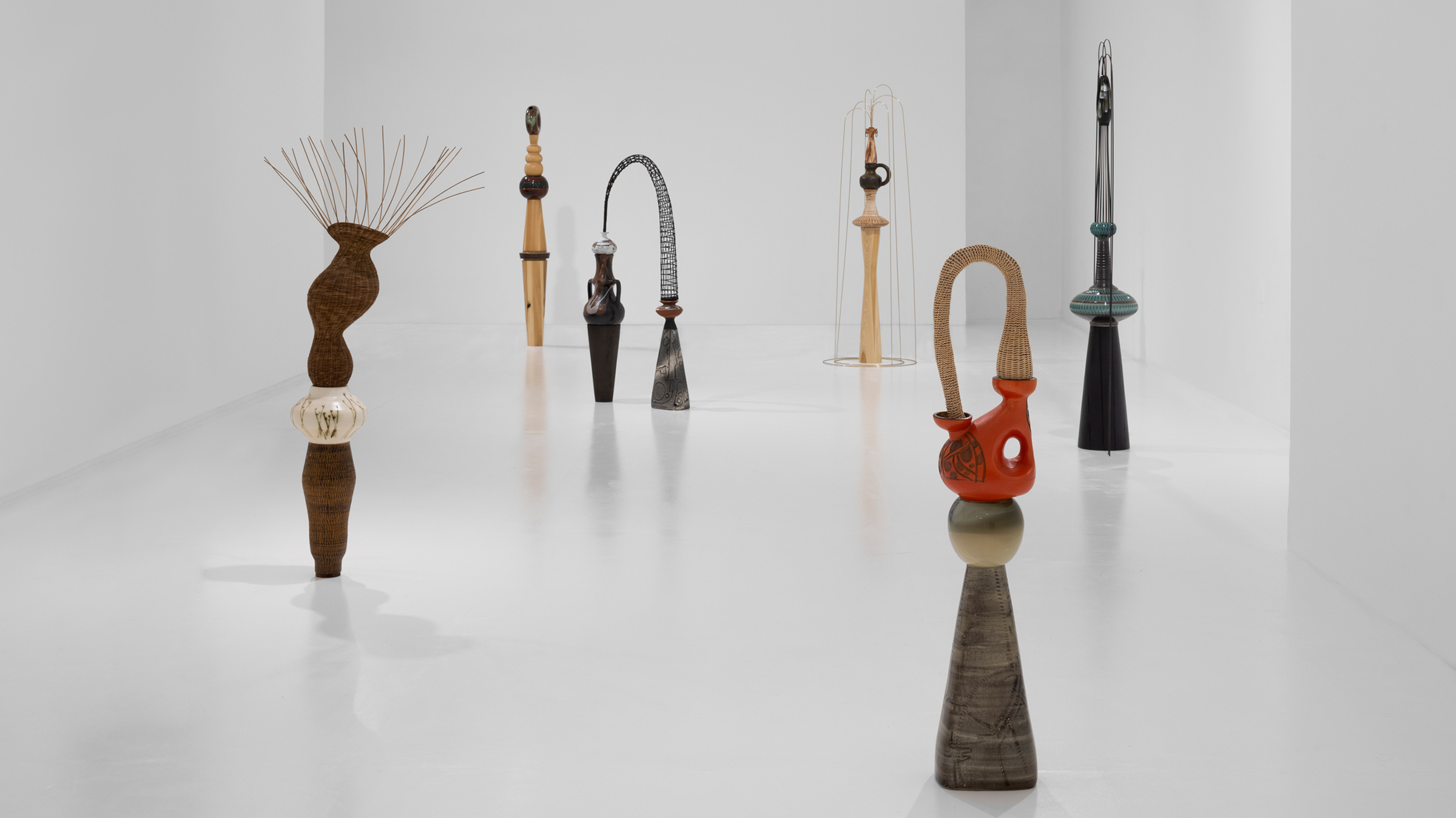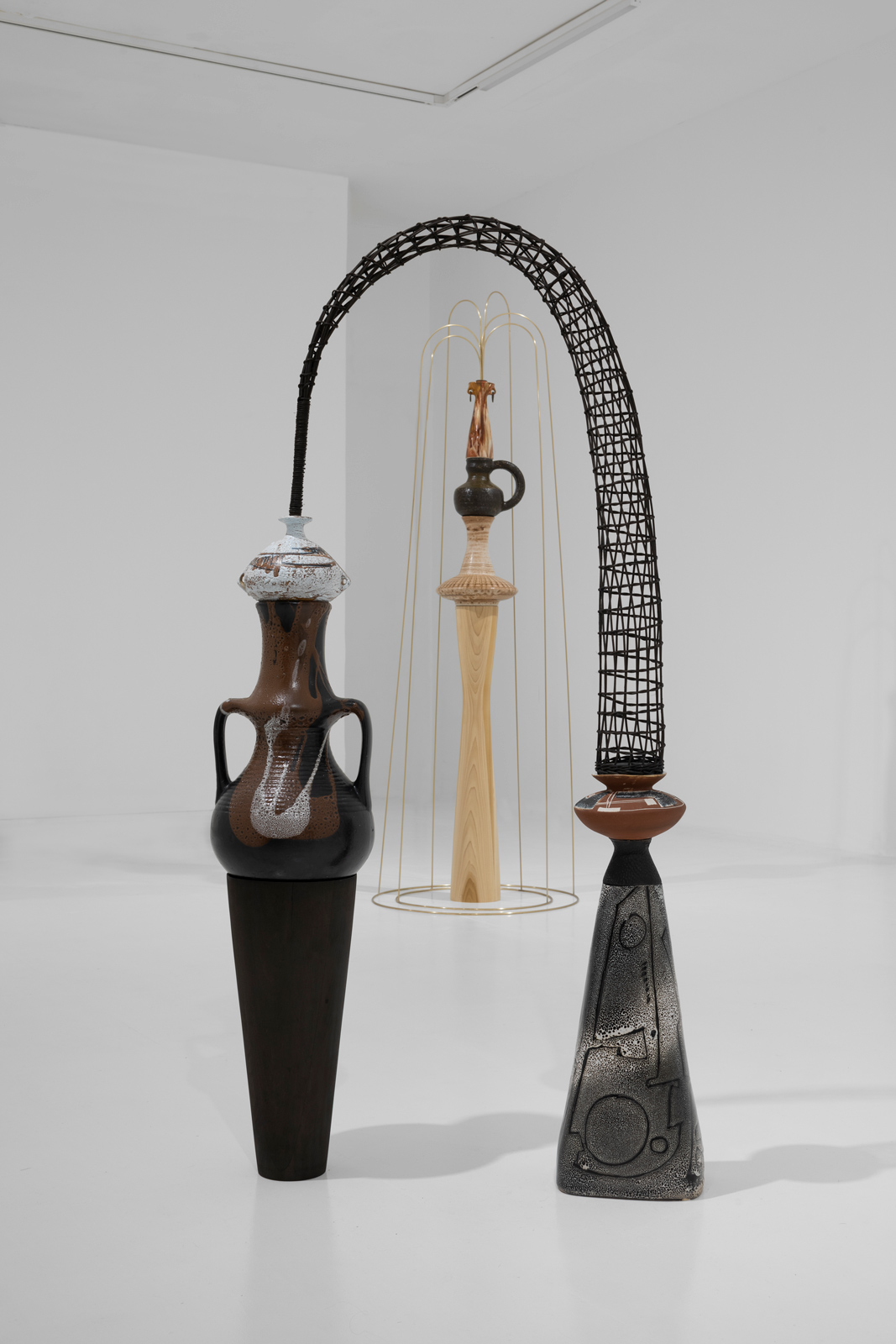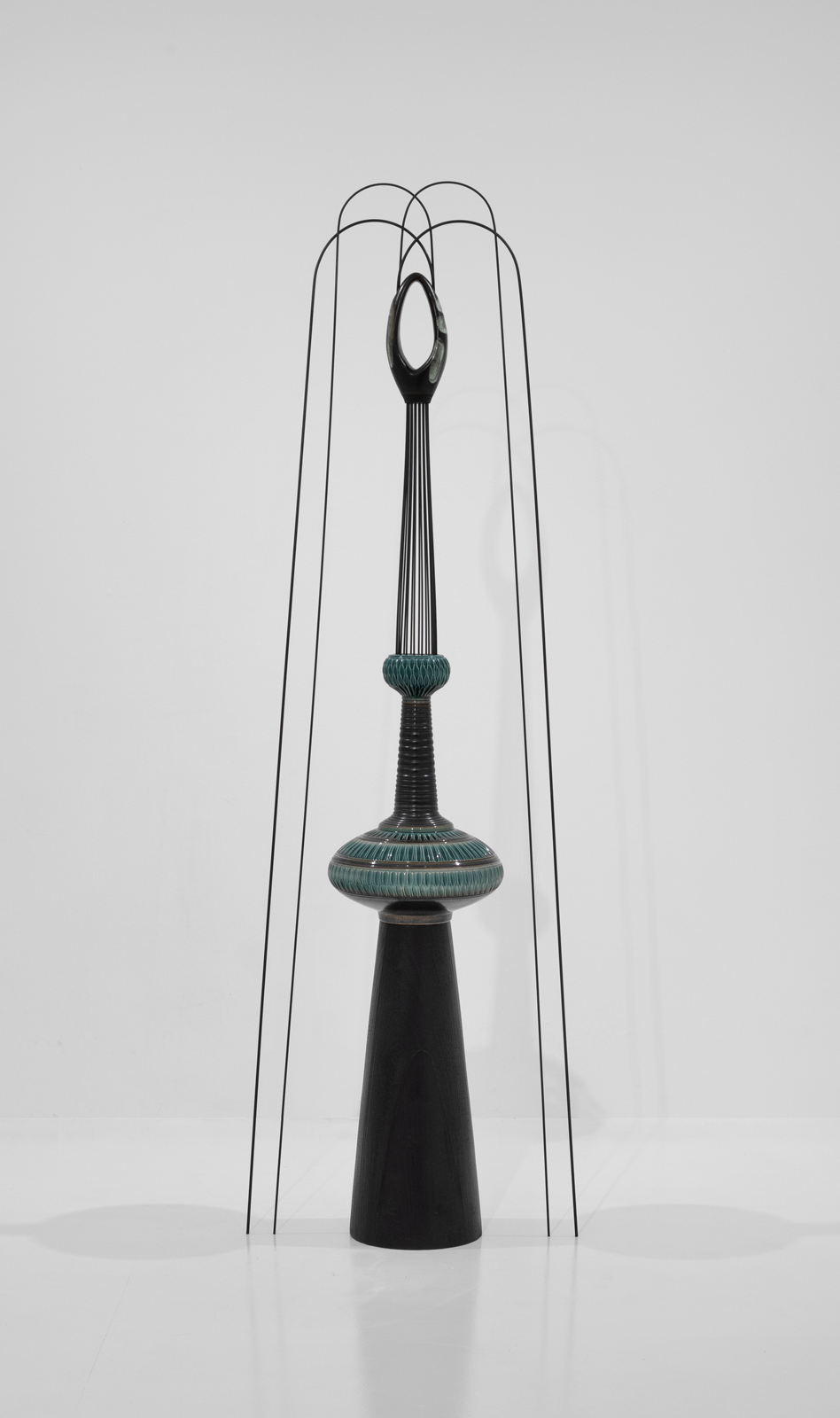The artist joins curator Julie Boukobza in conversation to speak on her love for found objects and seeing creative work as a meditative practice
For many visual artists, free time found in the pandemic offered an opportunity to evaluate and reflect, both spiritually and physically, on the work that they make. No different was it for Liora Kaplan, the celebrated Tel Aviv-based ceramicist known for her practice of giving found objects a second life. For Document, Kaplan joined French curator Julie Boukobza to discuss her craft: what it means to work horizontally, create at one’s own pace, and generate new feelings from old objects as a meditative practice
After revisiting her greatest influences—among them Romanian sculptor Constantin Brâncuși and French painter Sonia Delaunay—Kaplan emerged from quarantine imagining her work with a fresh, dimension-traveling mindset. She began building sculptures, sometimes working on several at once, which integrate historical vases that can be mined for memories from the past. Kaplan hopes that the viewer will feel ownership over their experience with her art. “The space between you and the work is charged with tension, and you can strongly feel it, hear it, like an echo,” she says. Letting go of the idea that visual art should be a solution to a problem, Kaplan embraces uncertainty and, in the process, discovers herself.
Julie Boukobza: In my first encounter with your work, through your exhibition at CCA Tel Aviv-Yafo, I was initially struck by how I could find a path—but not an automatic one—between the sculptures presented in the gallery. It was refreshing, as I often see sculptures exhibited in a ‘registered’ manner. Furthermore, your work seems based on a precarious equilibrium. Can you share your main influences?
Liora Kaplan: I had a couple of strong influences for this exhibition, the first being a spiral path labyrinth in Costa Rica made of San Pedro cacti. When I visited it for the first time, I imagined an exhibition that would be made of a kind of ‘forest of totems,’ where people would take nonlinear paths between the sculptures. The second one is Black Rock City, commonly known as Burning Man. The experience of feeling fully immersed in art—living in it and ‘morphing’ into it—makes you become one with the artwork, physically and spiritually.
Julie: You worked on this exhibition through the time of the pandemic. How was that experience? Many artists thought, ‘This is the time to think.’ Most of the people I know, especially women with kids, gave up producing in favor of being connected to family, friends, and nature. Was it difficult for you?
Liora: Thanks to the pandemic, I had a long period of time to dwell on my research and study my sources of inspiration more profoundly. I spent long periods of time with ‘my teachers,’ as I call them. At times, it was strange and maybe challenging, but when the last lockdown ended, suddenly I had this powerful spark of creativity and creation—a new beginning. Until that point, my nature was that of a problem solver. However, after this period of meditation and reflection, I decided that for this exhibition I would go against my nature, and not try and solve anything; everything will stay open-ended as I find myself working on everything, for the first time, horizontally. By that, I mean for this project, I worked on several sculptures at the same time—lingering, conversing with the materials of my work, and letting the vases at the core of each totem lead.
Julie: You let go, knowing you have no control.
One thing before we go into the vases: I am interested in your change of perspective. I curated an exhibition about ‘horizontal life,’ and how you move from lying to standing, about the ‘bed-perspective’ and its relationship to architecture. How do you go from one dimension to the next?
Liora: I didn’t really work in order. I looked at a vase, understood something about it, and made it happen while working on another one. The challenge was finding a conceptual and physical equilibrium—a center—as this process brought about this uncertainty. But that’s a mediation in its own right, and I enjoyed discovering myself and my practice through this lens.
Julie: It’s almost like threading a necklace.
Liora: Exactly. You mention ‘threading,’ and such an action, metaphorically and practically speaking, was a pivotal one—if not the one. The fuller vases in each sculpture are different heights, so when you are in the exhibition space at CCA, they feel like notes of a chord on a pentagram. There is a sense of sound, of music, as though there are some invisible threads going around.
Julie: Because they are vessels.
Liora: Yes, and hold in them sound that is frozen in time. As I expected, my studio practice was occupied with the craft itself—thinking out every detail from every possible angle, again physically and conceptually. In the end, my wish was to create a kinesthetic experience, a stage for the process of humanizing objects.
The space between you and the work is charged with tension, and you can strongly feel it, hear it, like an echo. Then, when you add a recognizable found object that has cultural significance, the tension becomes even more vivid. You start projecting onto it, and such a position generates an aura of significance and reverence.
Julie: I don’t know so much about the tradition of vases from the ’60s and ’70s in Israel. Can you share more?
Liora: A few years ago, I decided to go back to my roots. I wanted to start conceiving from a very personal place. For me, it was very important not to start at an intellectual or conceptual place, but rather look for something that is bigger than me. I decided that my starting point would be the home I grew up in—touching upon early childhood memories with my parents. The starting point was so very clear to me: It was a big vase that belonged to my father. He loved archaeology, and his study room was full of ancient vases. There was one in particular that I grew obsessed with. Since I was a little child, I would say, ‘One day this will be mine.’
Years later, with my father’s passing, the vase became mine. And at the same time, I decided to become a full-time artist. For the first two years, I moved to his study, which became my studio. And when my mother sold the house, I took the vase and it moved with me to my new studio. I knew I would one day do something with the vase, but I also did not want to use the vase itself in my work. It was too precious for me. I put it on pillows in my studio. I considered casting it, and when I did it, I found modern-day Hebrew writing on the bottom of it.
I learned it was not an ancient archeological find, and that blew my mind. Until that point, I was a hundred percent convinced that it was, and I just couldn’t believe it. I showed the photo of the signature to a friend of mine familiar with Israeli ceramics, and he told me that it was from the 1960s. He directed me to some interesting reading material about Israeli ceramics, and I was amazed to discover the creative renaissance and sensual exploration of that era. You must know that as Israelis, sadly, our collective history is oftentimes connected to war. Our timeline is paced by the start or end of a war, and often the expiation of you as an Israeli is to connect to that.
Julie: That’s my next question, actually. It was one of my initial thoughts upon discovering your work.
As someone very familiar with art from Israel, I find it intriguing that your exhibition has nothing to do with anything I know about contemporary Israeli art.
Liora: You are probably right about that, but actually I feel quite connected to the ceramic scene in Israel of those years, which was a way to establish a sense of identity. They combined archaeological shapes and proportions with mid-century European aesthetics, as many of them immigrated from Europe before or after the Holocaust. They then decided that the textures and colors should reflect the Israeli scenery—its landscape and earthy colors. It was such a beautiful moment for me to discover, a true revelation. I found a story—my story, if you wish—rooted in collective and personal memories. Then as I went further, I found out that my father also had a factory for ceramics. Can you imagine?
Julie: Really?
Liora: It was before he met my mom, so she didn’t know much except for the year and the city. I found out more details in an old newspaper, and then it all made sense. I understood that my favorite things from home were contemporary Israeli ceramics. Everything you see in the exhibition that is made of clay is actually objects I ‘hunt,’ and they echo the objects I grew up with.
Julie: While speaking about your work, the [Memphis design movement] comes to mind. I understand why, and yet I think it’s completely different from your work. The influence of Memphis on seeing design and craft as art is huge, but I feel it is more about pushing the limits. And in this case, we can only think about [Ettore] Sottsass.
Liora: Thank you for that. What I love most about Memphis is its literature, which I studied thoroughly. I found this catalog from 1984 from an exhibition in Canada called Phoenix, New Attitudes in Design, which featured a text by Barbara Radice—a founding member of Memphis and the only non-architect among them—that, for me, is like poetry. It encapsulates how I think about art, especially my art. It is originally about design and architecture, but feels so poignant. It speaks to the complexity of texture and how it’s supposed to seduce you, not give you answers. The title of the exhibition at CCA, Rhythms of Permanent Resonance, is in fact inspired by that text.
Julie: The exhibition Ettore Sottsass: The Magical Object at the Centre Pompidou gave me the opportunity to fully appreciate his practice, and I was completely taken by his writings. You can literally read what he was doing, and since I’m currently studying Italian, for me it was like a lesson in language and culture at the same time. I found his drawings seminal, as they really are artworks per se.
Liora: I completely understand what you mean. Through the meditative research process that I told you about earlier, I wanted to tell a story through unexpected juxtapositions that, for me, clearly influenced one another. One wall in my studio is dedicated to the people, places, and objects that inspire me. I have images and drawings of Brâncuși—my ‘spiritual father’—together with Memphis, Sonia Delaunay, and the labyrinth of San Pedro cacti. I don’t ever look to make obvious references. For me, everything simply has to reflect the path I am about to take: my story, my journey, my teachings. I always wanted to be an artist, but didn’t know how. And then when I found the path to be one, it all came together seamlessly and those funky turns along the way suddenly made sense. It also became apparent in the works.
Julie: Going deeper into your story—as reflected by the totems you create, your sculptures convey different types of histories all ‘mined’ by you. Spiritual in their resonance, they feel as though they connect to different times and places. Yet, you are right here, right now, in Israel, creating and producing work.
Liora: We spoke earlier about the importance of the gap between the visitor and the sculpture, and about the tension such a gap generates. When the works go out of my studio, a new conversation begins that doesn’t have to be related to me. I just set the ground; I lay the intentions and create a vessel that will carry and contain multiple thoughts and conversations. While this happens, I move away. I think, as an artist, it’s important to keep a distance. To create a space for the viewer’s experience and ownership of that experience. Now, I am at the beginning of the process of distancing; in a year, I am sure I will acquire a deeper understanding of these works.
Liora Kaplan: Rhythms of Permanent Resonance is on view at CCA Tel Aviv-Yafo until March 19, 2022.























